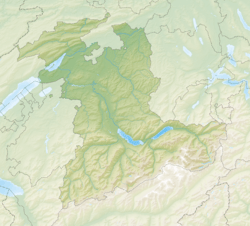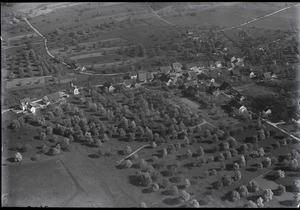Arni, Bern facts for kids
Quick facts for kids
Arni
|
||
|---|---|---|
|
||
| Country | Switzerland | |
| Canton | Bern | |
| District | Bern-Mittelland administrative district | |
| Area | ||
| • Total | 10.43 km2 (4.03 sq mi) | |
| Elevation | 849 m (2,785 ft) | |
| Population
(Dec 2020 )
|
||
| • Total | 936 | |
| • Density | 89.74/km2 (232.43/sq mi) | |
| Postal code |
3508
|
|
| Surrounded by | Biglen, Grosshöchstetten, Landiswil, Lauperswil, Oberthal, Walkringen | |
Arni is a small town, also called a municipality, in Switzerland. It is located in the canton of Bern, which is like a state or region. Arni is part of the Bern-Mittelland administrative district.
Contents
Arni's Past: A Quick Look at Its History
Arni was first mentioned way back in 1185! Back then, it was called Arne. In 1399, the powerful city of Bern likely took control of the village. It became part of a larger area called a Herrschaft, which was like a local lordship.
Later, in 1529, this Herrschaft system ended. Arni then became a Bernese bailiwick, which meant it was governed directly by Bern. In 1798, after the French invaded Switzerland, Arni became part of a new district. When that system changed in 1803, Arni joined the Konolfingen district.
Even today, Arni is still very much a farming community. Almost half of all jobs in the town are related to agriculture.
Exploring Arni: Geography and Land Use
Arni covers an area of about 10.4 square kilometers (4 square miles). A big part of this land, about 68.5%, is used for farming. This includes fields for crops and pastures for animals.
About 25.6% of Arni is covered by forests. These are mostly dense, thick forests. The remaining land, about 5.6%, is where buildings and roads are located. A very small part, about 0.1%, is made up of rivers or lakes.
The town of Arni itself includes the main village. It also has an industrial area called Arnisäge. Plus, there are two smaller villages, or hamlets, named Lütiwil and Roth.
In 2010, Arni joined a new administrative district called Bern-Mittelland.
Arni's Coat of Arms
Every town has a special symbol called a coat of arms. Arni's coat of arms has two main parts. The top part is silver and shows a golden fleur-de-lis, which is a fancy lily flower symbol. The bottom part is also golden and has a silver crescent moon.
Who Lives in Arni? Demographics
As of December 2010, Arni had a population of 945 people. A small number of these residents, about 3.4%, were foreign nationals. Over the past ten years (2000-2010), the population of Arni has slightly decreased.
Most people in Arni, about 97%, speak German as their main language. A smaller number speak Serbo-Croatian or French.
In 2008, the population was almost evenly split between males (50.7%) and females (49.3%). About 45% of the people living in Arni in 2000 were actually born there.
When we look at age groups (as of 2010):
- Children and teenagers (0–19 years old) make up about 20.4% of the population.
- Adults (20–64 years old) make up the largest group at 63.7%.
- Seniors (over 64 years old) make up about 15.9%.
In 2000, there were 84 households where only one person lived. There were also 50 households with five or more people. Most apartments in Arni are lived in all the time.
The chart below shows how Arni's population has changed over many years:

Interesting Places to See
The entire hamlet of Hämlismatt in Arni is very special. It is listed as part of the Inventory of Swiss Heritage Sites. This means it's a place with important history and culture.
Arni's Economy: How People Work
In 2011, Arni had a very low unemployment rate of 1.17%. This means almost everyone who wanted a job had one.
In 2008, there were 279 people working in Arni. Here's how they were employed:
- Primary sector: 147 people worked in this sector. This includes jobs like farming and forestry. There were 55 businesses in this area.
- Secondary sector: 41 people worked in this sector. This includes jobs in manufacturing (making things) and construction (building things). There were 15 businesses here.
- Tertiary sector: 91 people worked in this sector. This includes jobs in services, like shops, restaurants, education, and healthcare. There were 13 businesses in this sector.
Many people who live in Arni travel to other towns for work. In 2000, about 7.3% of workers used public transportation, and 54.4% drove their own cars to get to work.
Religion in Arni
Based on a 2000 survey, most people in Arni, about 83.3%, belonged to the Swiss Reformed Church (a type of Protestant church). About 4.2% were Roman Catholic.
A small number of people belonged to other Christian churches or to Islam. About 4.5% of the population did not belong to any church.
Education in Arni
Education is important in Arni. About 38.7% of the population has finished non-mandatory high school. Also, about 9.5% have gone on to higher education, like university.
The school system in the Canton of Bern works like this:
- One year of non-required Kindergarten.
- Six years of Primary school.
- Three years of required lower Secondary school. Here, students are grouped by their abilities.
- After lower Secondary, students can continue their education or start an apprenticeship (learning a trade on the job).
During the 2010-2011 school year, 100 students attended classes in Arni. There was one kindergarten class with 21 students. There were three primary classes with 64 students. And there was one lower secondary class with 15 students.
In 2000, 11 students came to Arni to attend school. However, 47 students from Arni went to schools outside the town.
See also
 In Spanish: Arni bei Biglen para niños
In Spanish: Arni bei Biglen para niños





